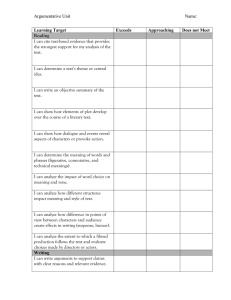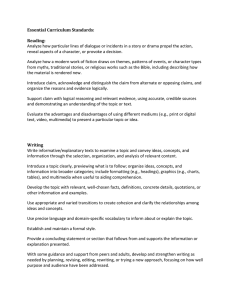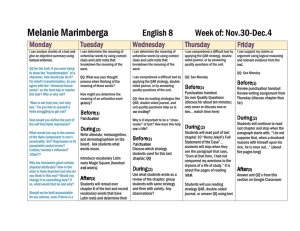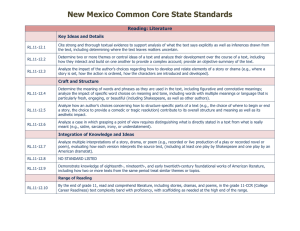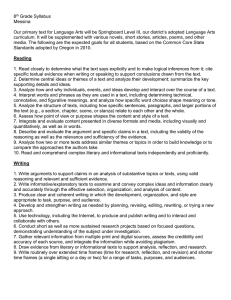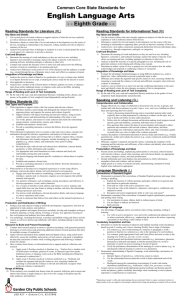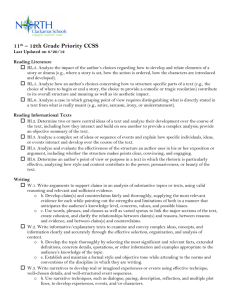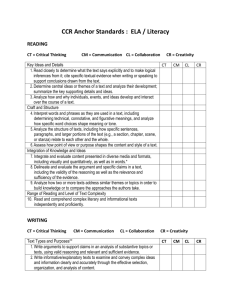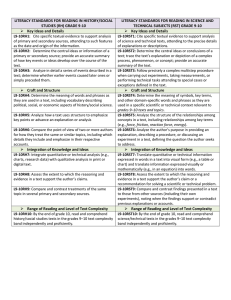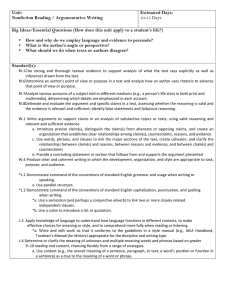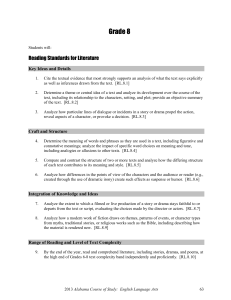9 -10 Grade Priority CCSS
advertisement
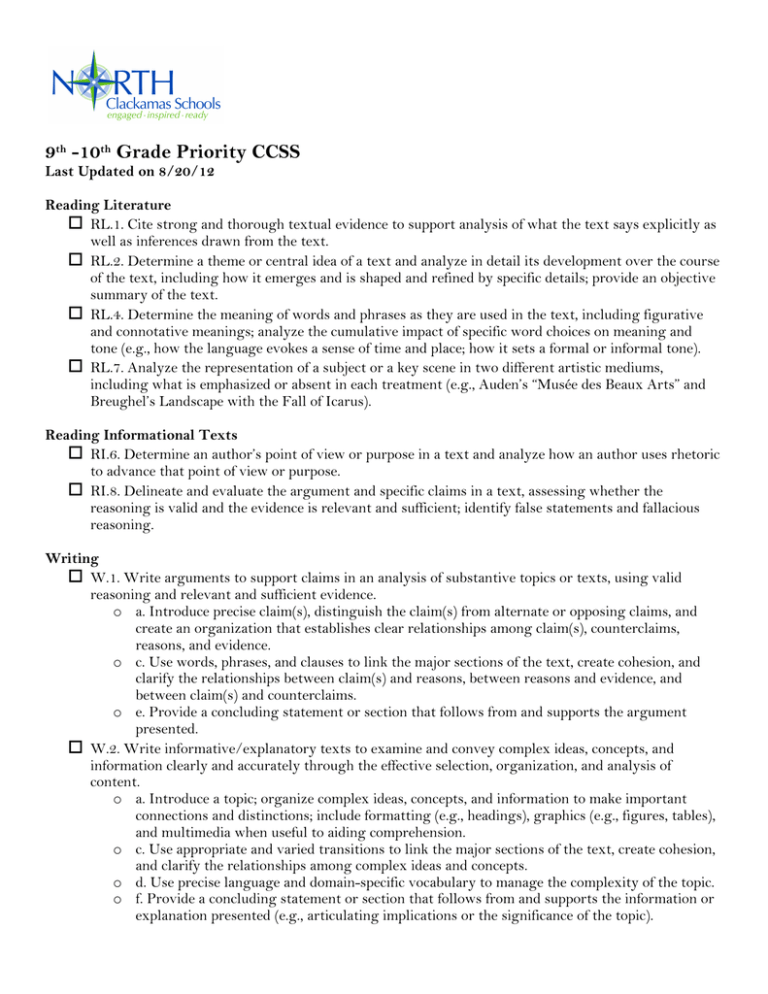
9th -10th Grade Priority CCSS Last Updated on 8/20/12 Reading Literature RL.1. Cite strong and thorough textual evidence to support analysis of what the text says explicitly as well as inferences drawn from the text. RL.2. Determine a theme or central idea of a text and analyze in detail its development over the course of the text, including how it emerges and is shaped and refined by specific details; provide an objective summary of the text. RL.4. Determine the meaning of words and phrases as they are used in the text, including figurative and connotative meanings; analyze the cumulative impact of specific word choices on meaning and tone (e.g., how the language evokes a sense of time and place; how it sets a formal or informal tone). RL.7. Analyze the representation of a subject or a key scene in two different artistic mediums, including what is emphasized or absent in each treatment (e.g., Auden’s “Musée des Beaux Arts” and Breughel’s Landscape with the Fall of Icarus). Reading Informational Texts RI.6. Determine an author’s point of view or purpose in a text and analyze how an author uses rhetoric to advance that point of view or purpose. RI.8. Delineate and evaluate the argument and specific claims in a text, assessing whether the reasoning is valid and the evidence is relevant and sufficient; identify false statements and fallacious reasoning. Writing W.1. Write arguments to support claims in an analysis of substantive topics or texts, using valid reasoning and relevant and sufficient evidence. o a. Introduce precise claim(s), distinguish the claim(s) from alternate or opposing claims, and create an organization that establishes clear relationships among claim(s), counterclaims, reasons, and evidence. o c. Use words, phrases, and clauses to link the major sections of the text, create cohesion, and clarify the relationships between claim(s) and reasons, between reasons and evidence, and between claim(s) and counterclaims. o e. Provide a concluding statement or section that follows from and supports the argument presented. W.2. Write informative/explanatory texts to examine and convey complex ideas, concepts, and information clearly and accurately through the effective selection, organization, and analysis of content. o a. Introduce a topic; organize complex ideas, concepts, and information to make important connections and distinctions; include formatting (e.g., headings), graphics (e.g., figures, tables), and multimedia when useful to aiding comprehension. o c. Use appropriate and varied transitions to link the major sections of the text, create cohesion, and clarify the relationships among complex ideas and concepts. o d. Use precise language and domain-specific vocabulary to manage the complexity of the topic. o f. Provide a concluding statement or section that follows from and supports the information or explanation presented (e.g., articulating implications or the significance of the topic). W.3. Write narratives to develop real or imagined experiences or events using effective technique, well-chosen details, and well-structured event sequences. o a. Engage and orient the reader by setting out a problem, situation, or observation, establishing one or multiple point(s) of view, and introducing a narrator and/or characters; create a smooth progression of experiences or events. o d. Use precise words and phrases, telling details, and sensory language to convey a vivid picture of the experiences, events, setting, and/or characters. o e. Provide a conclusion that follows from and reflects on what is experienced, observed, or resolved over the course of the narrative. W.4. Produce clear and coherent writing in which the development, organization, and style are appropriate to task, purpose, and audience. (Grade-specific expectations for writing types are defined in standards 1–3 above.) Speaking and Listening SL.1. Initiate and participate effectively in a range of collaborative discussions (one-on-one, in groups, and teacher-led) with diverse partners on grades 9–10 topics, texts, and issues, building on others’ ideas and expressing their own clearly and persuasively. o b. Work with peers to set rules for collegial discussions and decision-making (e.g., informal consensus, taking votes on key issues, presentation of alternate views), clear goals and deadlines, and individual roles as needed. o d. Respond thoughtfully to diverse perspectives, summarize points of agreement and disagreement, and, when warranted, qualify or justify their own views and understanding and make new connections in light of the evidence and reasoning presented. Language L.1. Demonstrate command of the conventions of standard English grammar and usage when writing or speaking. o a. Use parallel structure. L.2. Demonstrate command of the conventions of standard English capitalization, punctuation, and spelling when writing. o a. Use a semicolon (and perhaps a conjunctive adverb) to link two or more closely related independent clauses. o b. Use a colon to introduce a list or quotation. L.3. Apply knowledge of language to understand how language functions in different contexts, to make effective choices for meaning or style, and to comprehend more fully when reading or listening. o a. Write and edit work so that it conforms to the guidelines in a style manual (e.g., MLA Handbook, Turabian’s Manual for Writers) appropriate for the discipline and writing type. L.4. Determine or clarify the meaning of unknown and multiple-meaning words and phrases based on grades 9–10 reading and content, choosing flexibly from a range of strategies. o b. Identify and correctly use patterns of word changes that indicate different meanings or parts of speech (e.g., analyze, analysis, analytical; advocate, advocacy). L.5. Demonstrate understanding of figurative language, word relationships, and nuances in word meanings. o a. Interpret figures of speech (e.g., euphemism, oxymoron) in context and analyze their role in the text.
